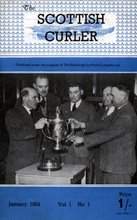 The first Mixed Doubles World Championship will be held in Vierumäki, Finland, March 9-15, 2008. Scotland's representatives for that event will be decided at a Scottish Mixed Doubles Championship at Murrayfield, December 21-23.
The first Mixed Doubles World Championship will be held in Vierumäki, Finland, March 9-15, 2008. Scotland's representatives for that event will be decided at a Scottish Mixed Doubles Championship at Murrayfield, December 21-23.Is is timely then that the Dewars Rinks, Perth, have organised a one day Mixed Doubles bonspiel for Saturday, December 8, 2007. Places are limited to twelve teams. For a cost of £30 per person every team is guaranteed five games. A buffet lunch is included, and there are prizes for the winning pair and the runners-up. Want to enter? The phone number for Linda Cowing at the rink is here.
In Scotland, pairs curling is a big part of the sport. There is a National Pairs Championship for example. And mixed doubles is considered by many just to be a variation of pairs. But other countries do not have this heritage. The World Curling Federation has produced a DVD to explain the mixed doubles game and has sent this to all member organisations. Thanks to the US Curling Association which has posted this on YouTube here, we can all watch it!
Key differences from regular curling are eight end games with five stones thrown by each team per end. Teams have one man and one woman. One player delivers first and last stone with the second player throwing stones two, three and four. The order that the players on a team throw can be changed during the game. Two other stones, one belonging to each team, are positioned before each end begins, at the back of the button and and between hog line and house on the centre line. No stones, including those in the house, can be removed from play until after three stones have been delivered.
If you have never played pairs curling before, there is a lot in the DVD to take in. For those who ARE familiar with pairs the unusual aspect of the game is the positioning of the two stones
 prior to each end. Who decides where these stones go?
prior to each end. Who decides where these stones go?The WCF rules say:
1. Prior to the start of every end, one team shall instruct the game umpire to place their team’s stationary stone (1), and their opponent’s stationary stone (1), in either position A or B:
A A stone bisecting the centre line, midway between the hog line and the front of the house; or
B A stone on the back half of the button, bisecting the centre line and touching the tee line.
2. The team having the decision on the placement of the stationary stones shall be:
(a) Unless predetermined, the teams opposing each other in the game shall use a coin toss to determine which team has the decision in the first end. (Note that at the World Mixed Double Championships, this will be determined by the Draw Shot Distance)
(b) Following the first end, the team that lost the end will have the decision on the placement.
(c) If an end is blanked, the team that did not deliver the last stone in that end shall have the decision on placement in the next end.
3. The team whose stationary stone is placed in the position in front of the house shall deliver first in that end, and the team whose stationary stone is placed in the house shall deliver the second stone of that end.
So, if you lost an end and it is your call as to where the stationary stones are to go, and you want to have last stone in the next end (as in normal curling), you have to put your opposition's stone in front of the house, and your own stone in the house. Your opposition then plays first. From watching the DVD where the first stones of an end are played, this is the scenario that played out.
From the rules, it would appear that you could do something completely different. If you had lost an end you could put your own stone out in front and put your opposition's stone in the house. You give away last stone advantage, but you get the first opportunity to attempt the freeze to the stone behind the button.
If I have this correct, it certainly puts an interesting slant on the game. The short DVD steers away from trying to explain this.
By the way, did you spot the deliberate mistake that the DVD commentator makes (no names to spare his blushes) in describing where the stones are placed prior to each end? YOU know where the tee line is, don't you?


No comments:
Post a Comment